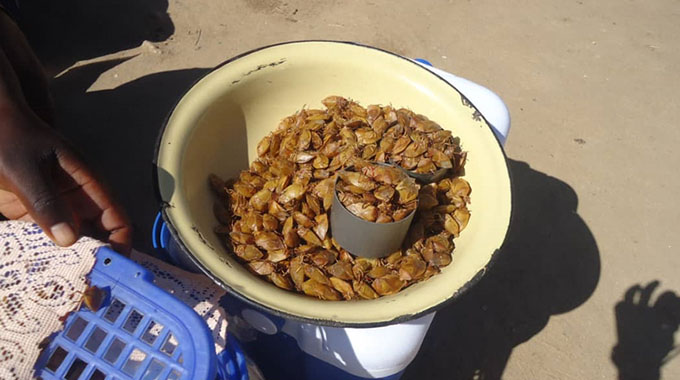Indigenous Knowledge Systems: ‘Harurwa Dzaunga’ Part 3

Claude Maredza
We now go back to the salient practices surrounding the age old tradition of the harurwa insects as practised by the people of Norumedzo village in Bikita District, Masvingo Province of Zimbabwe.
When the season of the insects Harurwa begins, people notice the insects’ arrival in Norumedzo because these insects fly all over making a very audible buzzing sound. If you look at the horizon or just up in the sky a little bit and against the sun, you actually see these insects criss crossing as they fly all over. This buzzing sound is called Kuunga in Karanga, which is the language people of Norumedzo speak and is the largest dialect of the main indigenous Shona language of Zimbabwe.
So when the people of Norumedzo see the insects and hear them buzzing as they fly all over the village, they say, “Harurwa dzaunga”. This literally means the insects Harurwa have buzzed. In other words, the insects have arrived for the start of the Harurwa season.
This happens in April/May of every year, year in year out.
The most intriguing point to note is that nobody knows where these insects come from.
They just announce their arrival every April/May through this buzzing as they fly all over the village and this has been happening from Nemeso’s time up to right now when you are reading this.
This makes it all the more imperative that a thorough study be done on these insects to really establish where they come from. For the time being, we can only go by what is known, and that is that Harurwa miraculously appear from nowhere for indeed until we know exactly where they come from it is correct to say that they miraculously appear from nowhere because they indeed miraculously appear from nowhere. There is a challenge for the keen researcher.
It is also pertinent to note that there are areas in Masvingo province such as the Murinye area near Great Zimbabwe monuments, where the insects also get seen during the harurwa season.
The connection here is that it is Chief Murinye who convinced Nemeso to go back and take his Chieftainship of Norumedzo.
This sighting of the harurwa insects in Chief Murinye’s area is clearly connected to Nemeso having been there at that time when he had been angered so much by his father. Nemeso decided to leave his kingdom until when chief Murinye, being a Duma elder and therefore close relative, with the matriarchal assistance of Nemeso’s mother, persuaded him to go back and assume his royalty of Norumedzo.
It should also be noted that Chief Murinye is part and parcel of the Vaduma dynasty, the largest grouping of the Karanga tribe, which in turn is the largest grouping of the Shona people who are the largest collection of indigenous Zimbabweans.
The Vaduma confederacy also incorporates Chief Mazungunye (whose royalty has a direct line to Nemeso, harurwa and the people of Norumedzo), Chief Mukanganwi, Chief Budzi, Chief Musukutwa. In fact, all the royalties in Bikita, Gutu, Zaka, Zimuto and related areas, Chief Mugabe, Chief Murinye as well as Chief Norumedzo himself and his own people and many other Moyos of the Vaduma dynasty all over the Masvingo province of Zimbabwe.
So by listening to the advice of Chief Murinye, Nemeso was in fact, listening to his elders.
It has also been reported that the insects harurwa are also seen in some parts of Chipinge in eastern Zimbabwe, which is also not a surprise because this is where Nemeso’s mother came from. Nemeso grew up in Chipinge.
So it would appear any other area where sightings of harurwa insects are reported have something to do with Nemeso. This emphasizes the spirituality and divinity of these insects and Nemeso himself.
However, wherever else these insects have been sighted, they are not looked after in the same systematic and organised way as they are looked after in their real original home, Nemeso’s kingdom, which is Norumedzo village, Bikita, Masvingo Province, in Zimbabwe.
Towards the evening when it becomes cooler, the insects settle on trees and grass.
It is also important to note at this stage, these insects only come in winter and they are easier to catch in the morning when it is cold and they tend to be very restless and fly off when it is hot. This could give further clues to any scientific study that may be undertaken to establish the habits of these insects and their other characteristics.
They then settle on any tree leaves or grass, whether these trees or grass are in the actual forest Jiri reHarurwa or not.
This is a very important point to note because the insects only settle in the forest Jiri reharurwa completely and nowhere else or any other part of Norumedzo village once the thanksgiving beer is brewed and offered to God through the ancestors to thank him for yet another season of these lucrative and delicious insects.
In Norumedzo, they actually say by brewing the thanksgiving beer, the elders will be divinely driving the insects into the forest where they should be. Before this beer is brewed, the insects can be found on trees and grass outside of the forest, so this thanksgiving beer is what divinely drives them into the forest, jiri reharurwa, their natural habitat.
Before this beer is brewed, people are allowed to catch these insects as they wish particularly those that will have settled on trees or grass outside the Jiri reharurwa or forest of the insects harurwa.
Doro ReHarurwa
Once it is noticed that the insects harurwa have arrived through the buzzing explained above, advisers to the elders will send an emissary to Chief Norumedzo to officially inform him and other elders that the insects have arrived. The way this is done is that when the emissary gets to the chief he says,
“ndatumwa kuti Vashe vaziviswe kuti murivo wakauya”.
This means, “I have been sent with the message that His Royal Highness the Chief must be officially and formally informed that the insects harurwa have arrived.”
Again this has to be understood completely. The staple food for Zimbabweans is sadza. This is a very filling meal made out of fine powder which results from the grinding of maize or rapoko or mhunga or sorghum or any other suitable edible grain.
Maize has become the main grain used for producing this powder or flour from which this sadza is made.
This sadza is always eaten with some accompanying relish, usually vegetables on their own, meat on its own or mixed with vegetables and many other forms of relish.
In the Arab/Islamic world, the equivalent of sadza is rootie and you can’t really eat rootie on its own but accompanied with relish. This relish is also usually meat in succulent gravy, vegetables etc.
In the Karanga dialect of the Shona language, murivo is the term used to refer to any relish which accompanies sadza.
In fact, due to cosmetic linguistic differences which really border on what dialect of Shona, Zimbabwe’s main indigenous language one speaks, some people in the country refer to only vegetables as murivo.
In Karanga, the main dialect of the main Shona language, murivo means anything that accompanies the staple sadza. It can be vegetables, meat or whatever, as long as it is accompanying the sadza it is called murivo in Karanga.
This is why they ask, ‘ sadza racho rine murivo wei?’ meaning what relish is accompanying the sadza?
This question would be ridiculously illogical if murivo was assigned the meaning of vegetables only as is done in some parts of Zimbabwe because this would amount to asking, ‘what vegetable is accompanying the sadza?’ which wouldn’t make any logical sense.
So the Karanga meaning of murivo which means any relish that accompanies the sadza, be that relish vegetables, meat or whatever is the correct version.
After all, Karanga is really the more correct root of all other dialects of Shona as it almost always has grammatical correctness.
It carries a dignity and respectability of originality that other dialects of Shona do not have. This is because other dialects, particularly the Zezuru, have been so infiltrated by urban slang. The Zezuru for example, as a dialect of Shona, is no longer that original in that regard as it has been infiltrated by urban slang more than other Shona dialects.
This is not a surprise because Zezuru is spoken mainly in the metropolitan area of Harare city and its environs. It was therefore naturally bound to be bastardized by the melting pot that Harare is considering the fact that the capital is a large sprawling metropolis with vast international connectivity.
This should not be confused with the fact that most Shona used for academic purposes also known as standard Shona in Zimbabwean schools, until recently tended to lean mainly on the Zezuru dialect of Shona.
The fact that the Zezuru dialect has until recently been the main Shona dialect in so called standard Shona is a mere accident and mistake of history, colonialism to be exact.
This is why Shona is being revised in academia as we speak so that it reflects itself in its fullness rather than in the Zezuru version only as what the so called standard Shona has erroneously represented for many years.
When the Cecil John Rhodes sponsored colonizing British pioneer column first established itself in our land at what they decided to name Fort Victoria, now back to its original name, Masvingo, just as it was before the arrival of this pioneer column colonialists, they decided to make this newly named Fort Victoria the capital city of this land they had just stolen which they renamed Rhodesia after Rhodes.
Claude Maredza is from Norumedzo village, Bikita District, Masvingo Province here in Zimbabwe.
e mail;[email protected]
phone: 00 263 (0) 77 2 382 099.










Comments